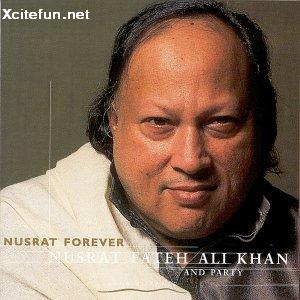
Nusrat Fateh Ali Khan's Style of Qawali
Nusrat is responsible for the modern evolution of Qawwali. Though not the first to do so, he popularized the blending of khayal singing and techniques with Qawwali. This, in short, took the form of improvised solos during the songs using the sargam technique, in which the performer sings the names of the notes he is singing. He also attempted to blend Qawwali music with more western styles such as techno.
Nusrat's Qawwali usually follows the standard form. A song begins with a short instrumental prelude played on the harmonium, accompanied by percussion. Then the instruments refrain, and the main singers launch into the alap, which establishes the raag, the tonal structure of the music. At this point, introductory poetic verses are sung. These are usually drawn not from the main song, but from thematically related songs. The melody is improvised within the structure of the raag.
After the introductory verses, the main song starts, and the rhythmic portion of the song begins. The tabla and dholak begin to play, and the chorus aids and abets percussion by clapping their hands. The song proceeds in a "call and response" format. The same song may be sung quite differently by different groups. The lyrics will be essentially the same, but the melody can differ depending on which gharana or lineage the group belongs to. As is traditional in Qawwali, Nusrat and the side-singers will interject alap solos, and fragments of other poems or even improvised lyrics. A song usually has two or three sets of refrains, which can be compared to the verse chorus structure found in western music. Songs last about twenty minutes on average, with a few lasting an hour or more.
Nusrat was noted for introducing other forms of improvisation into the style. From his classical music training, he would interject much more complex alap improvisations, with more vibrato and note bending. He would also interject sargam improvisations.
While it is undoubtedly difficult to put into words what makes Nusrat's music so deeply appealing to so many listeners, many of whom do not understand a single word of the languages he sings in, here is one fan's attempt to explain: "Nusrat's music invites us to eavesdrop on a man communing with his God, ever so eloquently. He makes the act of singing a passionate offering to God. But we do not merely eavesdrop. The deepest part of Nusrat's magic lies in the fact that he is able to bring our hearts to resonate with the music, so deeply, that we ourselves become full partners in that offering. He sings to God, and by listening, we also sing to God".
Nusrat Fateh Ali Khan (Volume 5)
Jay Tu Ankhiyan De Samne
Saanu Ik Pal Chain Na Aave
Saanu Ik Pal Chain Na Aave (Slow)
Sun Charke Di Meethi Meethi Ko
Saari Saari Raat Teri Yaad Stave
Saawan Ki Bheegi Raaton Mein
Shaman Payan Tere Bina Dholna
Shikwa
Surat Teri Shahe Umang (Qawali)
Mere Yaara Sun Mere Yaara

